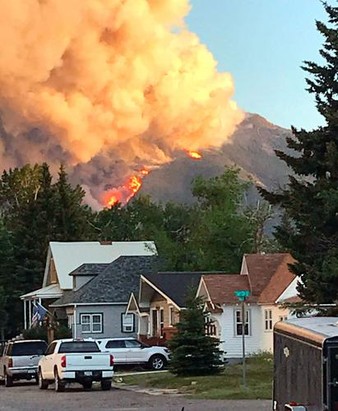Roberts Fire
Introduction
Text-to-speech Audio
In the summer of 2003, the Robert Fire was one of six large fires in and around Glacier National Park. These six fires together burned over a quarter of a million acres. The area burned inside the park was more than 10% of the total area of the park. The Roberts Fire grew from a fire started by a campfire. Some of the burned area can be seen to our left on the Apgar Mountains.
Images

Backstory and Context
Text-to-speech Audio
Throughout its 105-year history, wildfires have significantly altered Glacier National Park's landscape. The ongoing Reynolds Creek Fire, consuming over 2,000 acres near St. Mary, is the latest testament to this fiery influence. Notably, the 2003 Roberts Fire, scorching 57,570 acres along Lake McDonald, remains a stark reminder of the fire's enduring impact. This fire, despite being considered stand-replacing, exhibited mixed severity. Within its perimeter, 24% burned intensely, while 57% showed partial burn, leaving 19% unscathed. Such fires, including the one in 2003, illustrate fire's intricate role in the park's ecological narrative. With numerous significant blazes over the years, fire has profoundly shaped the park's rich history. Before the middle of the 20th century, most forest managers believed that all forest fires should be fought and put out. In the 1960s that policy began to be questioned. Scientific research increasingly demonstrated the positive role fire played in forest ecology. This led in the early 1970s to a radical change in Forest Service policy—to let lightning-caused fires burn when and where appropriate. Since around 1990, fire suppression efforts and policy have had to take into account the protection of an increasing number of homes being built in forested settings. Another issue the Forest Service now faces and what we hear about more and more in the news is that fires have grown in size and ferocity over the last 25 years. While forest and wildland fires may appear devastating, scientists tell us that fires can be beneficial to the landscape for several reasons:
- Fires clean out dead branches and leaves;
- Recycle nutrients into the soil;
- Provide essential heat for releasing seeds for trees such as the lodgepole pine;
- Provide openings for shade intolerant trees such as the ponderosa pine; and;
- Create diversity in habitat for wildlife.
One could argue that forest fires play a vital role in maintaining nature’s constant cycle of renewal – and that fires actually have hidden benefits.
Sources
1) Franz, J. (2015, July 22). A history of fire in glacier Park. Flathead Beacon. https://flatheadbeacon.com/2015/07/22/a-history-of-fire-in-glacier-park/
2) Guscio, C. G., Hossack, B., Eby, L. A., & Corn, P. S. (2007). Post-Breeding Habitat Use By Adult Boreal Toads (Bufo boreas) After Wildfire in Glacier National Park, USA. ResearchGate. https://www.researchgate.net/publication/237246785_Post-Breeding_Habitat_Use_By_Adult_Boreal_Toads_Bufo_boreas_After_Wildfire_in_Glacier_National_Park_USA#pf4
